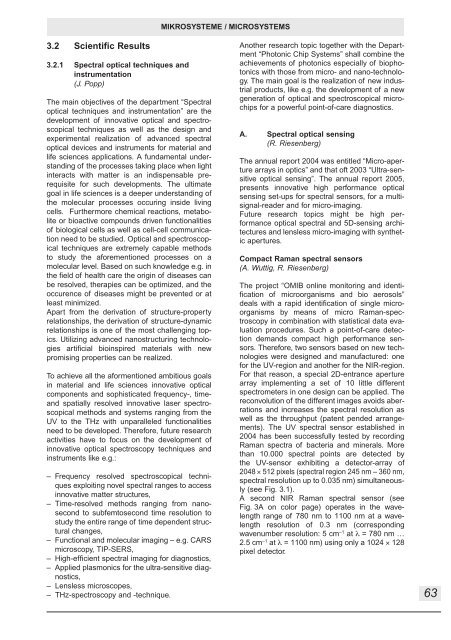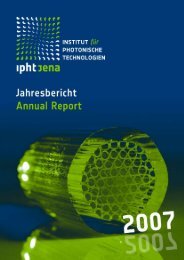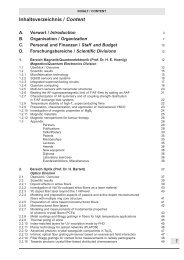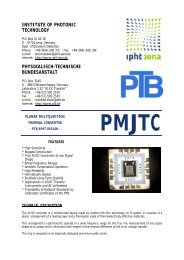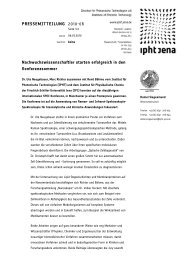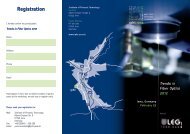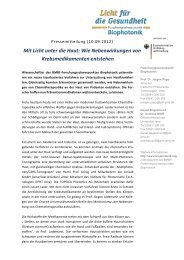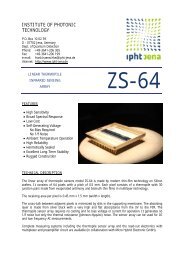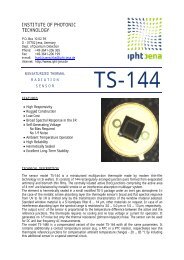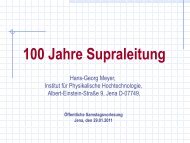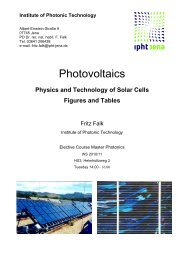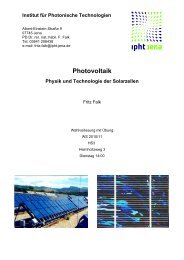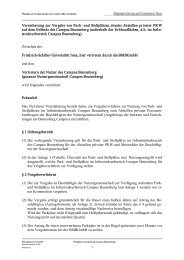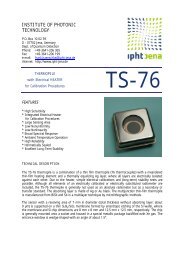Jahresbericht 2005 - IPHT Jena
Jahresbericht 2005 - IPHT Jena
Jahresbericht 2005 - IPHT Jena
You also want an ePaper? Increase the reach of your titles
YUMPU automatically turns print PDFs into web optimized ePapers that Google loves.
3.2 Scientific Results<br />
3.2.1 Spectral optical techniques and<br />
instrumentation<br />
(J. Popp)<br />
The main objectives of the department “Spectral<br />
optical techniques and instrumentation” are the<br />
development of innovative optical and spectroscopical<br />
techniques as well as the design and<br />
experimental realization of advanced spectral<br />
optical devices and instruments for material and<br />
life sciences applications. A fundamental understanding<br />
of the processes taking place when light<br />
interacts with matter is an indispensable prerequisite<br />
for such developments. The ultimate<br />
goal in life sciences is a deeper understanding of<br />
the molecular processes occuring inside living<br />
cells. Furthermore chemical reactions, metabolite<br />
or bioactive compounds driven functionalities<br />
of biological cells as well as cell-cell communication<br />
need to be studied. Optical and spectroscopical<br />
techniques are extremely capable methods<br />
to study the aforementioned processes on a<br />
molecular level. Based on such knowledge e.g. in<br />
the field of health care the origin of diseases can<br />
be resolved, therapies can be optimized, and the<br />
occurence of diseases might be prevented or at<br />
least minimized.<br />
Apart from the derivation of structure-property<br />
relationships, the derivation of structure-dynamic<br />
relationships is one of the most challenging topics.<br />
Utilizing advanced nanostructuring technologies<br />
artificial bioinspired materials with new<br />
promising properties can be realized.<br />
To achieve all the aformentioned ambitious goals<br />
in material and life sciences innovative optical<br />
components and sophisticated frequency-, timeand<br />
spatially resolved innovative laser spectroscopical<br />
methods and systems ranging from the<br />
UV to the THz with unparalleled functionalities<br />
need to be developed. Therefore, future research<br />
activities have to focus on the development of<br />
innovative optical spectroscopy techniques and<br />
instruments like e.g.:<br />
– Frequency resolved spectroscopical techniques<br />
exploiting novel spectral ranges to access<br />
innovative matter structures,<br />
– Time-resolved methods ranging from nanosecond<br />
to subfemtosecond time resolution to<br />
study the entire range of time dependent structural<br />
changes,<br />
– Functional and molecular imaging – e.g. CARS<br />
microscopy, TIP-SERS,<br />
– High-efficient spectral imaging for diagnostics,<br />
– Applied plasmonics for the ultra-sensitive diagnostics,<br />
– Lensless microscopes,<br />
– THz-spectroscopy and -technique.<br />
MIKROSYSTEME / MICROSYSTEMS<br />
Another research topic together with the Department<br />
“Photonic Chip Systems” shall combine the<br />
achievements of photonics especially of biophotonics<br />
with those from micro- and nano-technology.<br />
The main goal is the realization of new industrial<br />
products, like e.g. the development of a new<br />
generation of optical and spectroscopical microchips<br />
for a powerful point-of-care diagnostics.<br />
A. Spectral optical sensing<br />
(R. Riesenberg)<br />
The annual report 2004 was entitled “Micro-aperture<br />
arrays in optics” and that oft 2003 “Ultra-sensitive<br />
optical sensing”. The annual report <strong>2005</strong>,<br />
presents innovative high performance optical<br />
sensing set-ups for spectral sensors, for a multisignal-reader<br />
and for micro-imaging.<br />
Future research topics might be high performance<br />
optical spectral and 5D-sensing architectures<br />
and lensless micro-imaging with synthetic<br />
apertures.<br />
Compact Raman spectral sensors<br />
(A. Wuttig, R. Riesenberg)<br />
The project “OMIB online monitoring and identification<br />
of microorganisms and bio aerosols”<br />
deals with a rapid identification of single microorganisms<br />
by means of micro Raman-spectroscopy<br />
in combination with statistical data evaluation<br />
procedures. Such a point-of-care detection<br />
demands compact high performance sensors.<br />
Therefore, two sensors based on new technologies<br />
were designed and manufactured: one<br />
for the UV-region and another for the NIR-region.<br />
For that reason, a special 2D-entrance aperture<br />
array implementing a set of 10 little different<br />
spectrometers in one design can be applied. The<br />
reconvolution of the different images avoids aberrations<br />
and increases the spectral resolution as<br />
well as the throughput (patent pended arrangements).<br />
The UV spectral sensor established in<br />
2004 has been successfully tested by recording<br />
Raman spectra of bacteria and minerals. More<br />
than 10.000 spectral points are detected by<br />
the UV-sensor exhibiting a detector-array of<br />
2048 × 512 pixels (spectral region 245 nm – 360 nm,<br />
spectral resolution up to 0.035 nm) simultaneously<br />
(see Fig. 3.1).<br />
A second NIR Raman spectral sensor (see<br />
Fig. 3A on color page) operates in the wavelength<br />
range of 780 nm to 1100 nm at a wavelength<br />
resolution of 0.3 nm (corresponding<br />
wavenumber resolution: 5 cm –1 at λ = 780 nm …<br />
2.5 cm –1 at λ = 1100 nm) using only a 1024 × 128<br />
pixel detector.<br />
63


